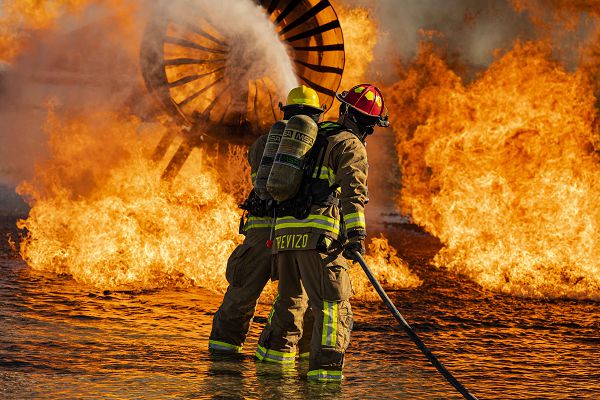
Nellis Air Force Base, Nevada. (January 12, 2024): Unlike their civilian counterparts, Air Force Fire Protection Specials face hazards that are unique to flight operations. In this photo by Senior Airman Zachary Rufus, Airman 1st Class Kyle Datu and Staff Sergeant Matt Trevizo with the 99th Civil Engineering Squadron extinguish a fire during an aircraft live fire training exercise. The training employed propane ignitors built into multiple positions throughout and around the training fuselage to give firefighters a realistic training environment.
Air Force Firefighters must deal with everything from grass fires to exploding rocket fuel and be ready to respond to aircraft emergencies around the clock. They are also responsible for specialized rescues, hazardous material responses, and even weapons of mass destruction. Air Force Firefighters are required to complete these training sessions twice a year under both day and night conditions to maintain their certification.
To become an Air Force Firefighter, a candidate must meet entry qualifications and pass seven and one-half weeks of basic training. Fire protection specialists then attend 68 days of technical training at Goodfellow Air Force Base, Texas at the Louis F. Garland Fire Academy. Taught by the 17th Training Wing, the Air Force firefighter course is one of the most difficult in the world. The course is divided into six blocks of instruction of various length that include:
- First Responder/EMS
- Fire Protection Fundamentals/Fire Behavior
- Structural Firefighting/Vehicle Extrication
- Structural Fire Ground Operations
- Hazardous Materials Awareness and Operations
- Airport Firefighting
Firefighters must also know cardiopulmonary resuscitation and other basic emergency medical knowledge as first responders. They must also be qualified in the proper use of fire hose appliances, forcible entry and ventilation tactics, and the proper wearing of personal protective equipment. In wartime, Air Force firefighters would deploy to bases around the world to manage catastrophic emergencies. Thankfully for us, they can take the heat.


